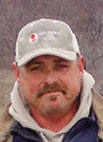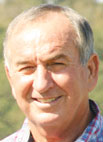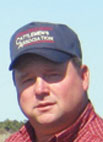
Years ago a popular TV commercial carried the tagline of “It’s not nice to fool Mother Nature.” Todd Weyl, who lives in Fayetteville, Ark., on a small purchased acreage but runs his parents’ 228-acre farm in Lincoln, Ark., has learned through trial and error and through extensive observation and reading that allowing Mother Nature to have dominance in farming leads to a paradigm shift. Todd views agriculture as an interdependent system where superimposing solutions to problems may solve a particular problem but harms the system. Todd said, “This is not about going ‘natural’ for the environment’s sake but increasing profitability by decreasing costs naturally.”
The Weyl farm maintains 60 momma Santa Gertrudis/Red Angus cross cows and one Red Angus bull. Todd grew up showing Santa Gertrudis heifers in 4-H and believes the breed raises good calves quickly. However, it is a larger breed so the cross has a goal of 1,100 to 1,200 pound cows rather than the breed average of 1,650 pounds. Smaller cows mean more cows per acre while maintaining the calving and raising advantages of the Santa Gertrudis breed.
Todd selected a Red Angus bull from a breeder in Colorado who develops bulls that adapt to diverse environments, in other words a hardier bull. In addition, Todd’s bull scored high on calving ease resulting in Todd not losing one calf this year. Further, none of the calves needed supplemental grain but flourished on cows’ milk and grazing.
One day, Todd took the time to observe a calf being born. The calf was standing and nursing 5 minutes after birth. Todd said, “I think many beneficial and natural responses have been bred out of cattle breeds.”
Another hands-off practice Todd uses with his cattle is vaccinating only replacement heifers for blackleg and lepto in order to allow natural immunities to work. Additionally, Todd has not dewormed his cattle for 12 years but rather allows natural selection to work. Todd said, “If an animal does not adapt well to this hands-off approach, I cull it immediately. Sometimes I lose one, but in the long run I have a strong herd with minimal inputs, and that saves money.”
In order for this holistic system management to work, the same hands-off philosophy is applied to the land. Todd said, “Land is not to be used; it is to be managed and nurtured.” Half of Todd’s land is open pasture and half is timber. Years ago Todd attempted to bale hay on the pasture portion, but the land was too rough and tore up more equipment than money he saved by feeding his own hay. Now Todd purchases and feeds one bale of hay a day January through March only. He pays close attention to where he rolls out the bales because seeds in the bales reseed his pastures. He rotates cattle by need rather than according to a schedule with some of the cattle’s time spent foraging in the timber as well as in the pastures. To keep the cattle safe when foraging in the timber, after bad storms Todd checks for downed black cherry limbs and dangerous holes. Todd said, “The cattle earn their keep by managing timber and timber forage is an important part of their diet.”
Todd neither fertilizes nor sprays his pastures. One result is the strong presence of dung beetles who Todd has watched break up a cow patty within hours, thereby aiding natural decomposition and fertilization. Spraying kills helpful insects and earthworms as well as parasites, a trade-off Todd is not willing to make especially since his cattle thrive without spraying. Further, not spraying may have led to less toxicity in many forage plants others consider weeds such as curly dock, sour dock and even thistles. Thistles have protein content similar to alfalfa. Todd has a few donkeys who love to eat the buds while the cattle eagerly consume the rest of plant.
This year Todd plans on introducing the cattle to eating multiflora rose, a foreign thorn bush introduced years ago for hedges. He will put some of the greenery in tubs adding a little bit of grain to encourage the cattle to try the new forage. The process is similar to introducing babies to new foods, a tactic he learned at a recent seminar. Todd said, “Cattle eat what tastes good because the brain tells them it’s safe. This process will help the brain learn that the new forage is safe.”
Todd fed no hay during the drought, did not decrease the size of his herd and did not lose any animals. During that time, the local power company was clearing timber around power lines that crossed his land. Todd had workers leave the downed trees as forage for his cattle and had sufficient water in a spring fed pond, and newly dug 300’ well.







